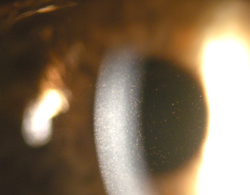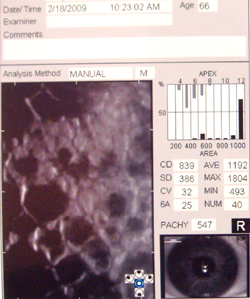Cataract surgery can help some cases of Fuchs’ endothelial dystrophy
Fuchs’ endothelial dystrophy is a genetic disorder in which the corneal endothelium becomes progressively weak, leading to corneal decompensation and decreased vision. Because Fuchs’ worsens with time, patients tend to present with symptoms of decreased vision in their 60s and 70s. They often have concurrent cataracts, which may further worsen vision.
 Uday Devgan |
The surgical treatment of Fuchs’ is corneal transplantation, with current techniques of endothelial transplantation gaining popularity over full-thickness transplantation. These patients may initially do quite well and have improved vision with cataract surgery alone, which is a far simpler surgical procedure. Because Fuchs’ is a progressive disease, endothelial cell function is expected to decline with age. Patients should be informed that cataract surgery may improve or preserve their vision for years, but eventually their corneas may decompensate and require future transplantation.
Preoperative evaluation
The decreased vision is likely due to both the cataract and the weakened corneal endothelium, so it is important to determine the amount of visual improvement likely after cataract surgery alone. If the cornea has guttae, light dusting of pigment and mild endothelial cell loss, then performing phacoemulsification with lens implantation would likely result in a significant visual improvement. If the cornea has progressed to diffuse edema with bullae formation, a combination procedure of cataract surgery with endothelial transplantation may be more appropriate.
The corneal endothelial cells can be directly visualized and assessed using specular microscopy, and a central endothelial cell density can be determined. At densities less than 1,000 cells/mm2, the risks of significant corneal decompensation with cataract surgery increase. Another important preoperative measurement is the central corneal pachymetry, with a higher value indicating a more damaged and edematous cornea. As the endothelium weakens, these cells are unable to fully pump the water out of the cornea and the corneal stroma swells, thereby increasing the measured pachymetry. It has been suggested that corneas with a pachymetry of 600 µm or less would do well with cataract surgery alone, whereas those with pachymetry above 640 µm may benefit from a combined cataract surgery and corneal transplantation.
 Slit lamp appearance of corneal guttae and mild corneal haze in a patient with Fuchs' endothelial dystrophy. |
 Specular microscopic evaluation reveals central loss of corneal endothelial cells in a patient with Fuchs' endothelial dystrophy. Images: Devgan U |
Surgical technique
Because essentially all anterior segment intraocular procedures tend to cause slight losses in corneal endothelial cell count, it may be better to perform cataract surgery at an earlier stage in Fuchs’ patients. At these early stages, the cataracts tend to have less density and therefore require less ultrasonic energy to be removed. The ultrasonic energy combined with the fluid flow through the anterior segment may cause a higher degree of endothelial cell loss during surgery.
Ultrasonic power modulations can be programmed into the phaco machine in order to deliver shorter pulses or bursts of phaco energy. While the foot pedal can be used to deliver blocks of 1 or 2 seconds of energy, the power modulations allow much smaller increments, such as 2 to 4 milliseconds. Combining lateral phaco, such as transversal or torsional, with longitudinal phaco may be beneficial. However, the best way to decrease ultrasonic energy is using a mechanical method, such as chopping, to disassemble the nucleus.
The flow of the balanced salt solution during the phaco procedure can create currents against the endothelial cells, inducing damage. Using low-flow parameters and snug incisions and staying away from the cornea during surgery can be beneficial. In order to provide a barrier to protect the cornea, a dispersive viscoelastic, such as Healon D (Advanced Medical Optics), Viscoat (Alcon) or perhaps OcuCoat (Bausch & Lomb), should be injected at the beginning of the procedure. Because the irrigation fluid can wash away the dispersive viscoelastic, it can be periodically reapplied during surgery. The soft-shell technique of using a dispersive viscoelastic against the endothelium, followed by a super-cohesive viscoadaptive agent such as Healon 5 (AMO), has been shown to be particularly effective.
Due to the compromised cornea, these eyes tend to do better with monofocal or accommodating IOLs instead of multifocal lenses. With compromised endothelial cell function, the incisions may not seal securely and placing a suture would be better than excessive corneal stromal hydration.
Postoperative course
Despite the efforts made to protect the corneal endothelium during surgery, these patients may have significant corneal edema in the immediate postoperative period. Important postop medications include steroids and nonsteroidals to control inflammation, antibiotics for infection prophylaxis and often hypertonic saline to aid with corneal clarity. The postoperative course can be prolonged; however, most patients with reasonable preoperative corneal pachymetry and endothelial cell counts will recover their baseline level of corneal clarity and good vision.
References:
- Jurkunas U, Azar DT. Potential complications of ocular surgery in patients with coexistent keratoconus and Fuchs’ endothelial dystrophy. Ophthalmology. 2006;113(12):2187-2197.
- Seitzman GD. Cataract surgery in Fuchs’ dystrophy. Curr Opin Ophthalmol. 2005;16(4):241-245.
- Seitzman GD, Gottsch JD, Stark WJ. Cataract surgery in patients with Fuchs’ corneal dystrophy: expanding recommendations for cataract surgery without simultaneous keratoplasty. Ophthalmology. 2005;112(3):441-446.
- Tarnawska D, Wylegala E. Effectiveness of the soft-shell technique in patients with Fuchs’ endothelial dystrophy. J Cataract Refract Surg. 2007;33(11):1907-1912.
- Uday Devgan, MD, FACS, is in private practice at Devgan Eye Surgery in Los Angeles, Beverly Hills, and Newport Beach, California. Dr. Devgan is Chief of Ophthalmology at Olive View UCLA Medical Center and an Associate Clinical Professor at the Jules Stein Eye Institute at the UCLA School of Medicine. Dr. Devgan can be reached at 11600 Wilshire Blvd., Suite 200, Los Angeles, CA 90025; 800-337-1969; fax: 310-388-3028; e-mail: devgan@gmail.com; Web site: www.DevganEye.com. Dr.Devgan is a consultant to Abbott Medical Optics and Bausch & Lomb, and is a stockholder in Alcon Laboratories and formerly in Advanced Medical Optics.









